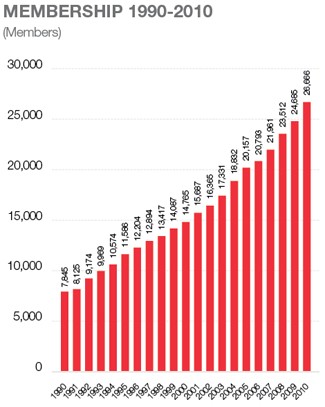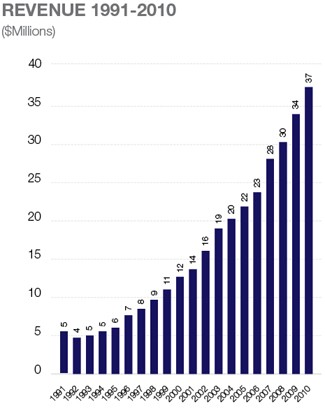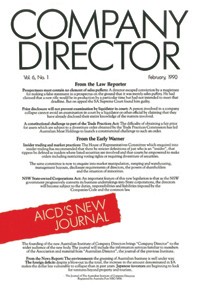To mark its 21st anniversary, Domini Stuart reviews why the Australian Institute of Company Directors was formed and how its role and services have changed over the years to meet the evolving needs of its members.
Happy 21st
Past presidents
1990-1992 Sir Eric Neal AC CVO FAICDLife
1993-1995 Sir Bruce Watson AC
1996 Mr Richard Fidock AO FAICDLife
1997 Mr John Ralph FAICDLife
1998-2000 Mr Richard Warburton AO FAICD
2001-2003 Miss Elizabeth Alexander AM FAICD
2004-2006 Mr Donald Mercer FAICD
2007-2009 Mr John Story FAICD
2010-Current Mr Richard Lee FAICD
At the beginning of 1990, there were two organisations for Australian company directors. The Institute of Directors – originally a branch of the Institute of Directors in London – focused on providing networking opportunities at business lunches and dinners and tended to attract directors from large companies. The Company Directors Association of Australia focused more on education and was more likely to appeal to aspiring directors or those on the boards of smaller companies.
Despite their broad differences, they were essentially competing in the same marketplace for the same membership. "There were also two organisations making submissions to Federal and state governments and purporting to be the voices of company directors," recalls Sir Eric Neal AC CVO FAICDLife. "The boards of both organisations acknowledged this was counterproductive and that the community would be better served if the two were to merge – and I think we should pay tribute to those board members for having the vision to bring the two organisations together."
By the end of 1990, the Australian Institute of Company Directors had been established with Sir Eric as its first national president. Both former chairmen favoured someone who had not been active in either organisation. As chairman of Westpac, Metal Manufacturers and Atlas Copco and a director of BHP Billiton, Boral and Coca-Cola Amatil, Sir Eric was the ideal candidate – and he was sufficiently impressed by their purpose and foresight to take on the role.
"The timing of the merger was opportune in that, in my opinion, the succeeding 21 years have seen a far greater emphasis on corporate governance and the role and responsibilities of directors," he says. "The need for an organisation such as the Australian Institute of Company Directors was certainly there at the beginning and has increased year by year."
Changes in the boardroom
The Australian Institute of Company Directors has supported major changes within the boardroom.
"Twenty or 30 years ago, directors were practically all men and mostly older men who already knew each other," says David Gonski AC FAICDLife. "There is now a very different approach to selection. The Australian Institute of Company Directors can justifiably be proud of the role it is continuing to play in opening up opportunities for the 50 per cent of the population who weren’t represented on a gender basis."
The 2004 publication Evaluating Board Performance – A Guide for Company Directors reflected another significant shift in thinking.
"Board evaluations were not commonplace 21 years ago," says John Ralph AC FAICDLife, who was national president in 1997 and who chaired the Corporate Governance Committee for five years until April 2009. "Although action may have been taken by a chairman in relation to a particular director’s board membership, usually in a discreet manner, in a formal sense it wouldn’t have been on many agendas at all. These days, it’s taken very seriously."
Nevertheless, Ralph is just one of many concerned about the growing burden of compliance. "Obviously you need to ensure the company is complying with its legal and fiduciary obligations, but too much emphasis on compliance because of personal financial or reputational concerns could distract the board from driving company performance, which is an equally important aspect of the job."
Another potential distraction is the threat of litigation. In 1990 there was no such thing as a class action against a company or its directors in Australia. "Ultimately, boards are charged with ensuring the funds of the shareholders are being prudently managed," says Ralph. "That doesn’t mean preventing every mistake and it doesn’t mean micro-managing the company. There’s some confusion in the community as to the role of the board; one of the roles of a body like the Institute is to help the community understand what they can and cannot reasonably expect of directors."
Shareholders once formed a relatively homogeneous group of wealthy individuals relying on advice from their stockbrokers. Today, superannuation has made shareholders of most Australian workers. Many take an active, personal interest in corporate performance and technology has provided them with access to unprecedented amounts of information – 21 years ago there was no public internet, barely one per cent of the population had a mobile phone and financial news was still regarded as a specialist subject of little interest to the general public.
"When I started with the Australian Institute of Company Directors 19 years ago, people would ask me what I did and when I tried to explain, they had no idea what I was talking about," says Rob Elliott, general manager Policy and General Counsel. "Now I can go to any barbecue or party and people don’t just understand, they’ve got a view on the subject. Directors are more visible and they’re seen as more relevant and important to individuals rather than just within the business world."
There has been a consequent shift in how directors perceive themselves.
"Being a director used to be an honour – directors were regarded as incredibly important, their decisions were not questioned and their visibility in terms of publicity and disclosure was not extensive," says Gonski. "Now, while it’s a very good thing to be a director, I would hardly call it an honour. Directors’ decisions are regularly challenged and what they say is fully disclosed. And, while I think these are positive changes, it does mean the job is harder. You need more skills and technical ability to handle it."
Responding to a need
The Australian Institute of Company Directors continues to provide directors with the resources to do their jobs well in the face of changing demands.
"A large not-for-profit board I sit on decided to offer directors the opportunity to do the Company Directors Course," says Gonski. "Those who did, showed an immense improvement in their ability to participate, their self-esteem around the board table and, I think, their general contribution to the organisation. I was incredibly impressed by their willingness to put the time in and also by the ways in which we all benefited from their participation in just a one-week course."
The flagship Company Directors Course was originally a joint venture with the University of New England and conducted at universities around the country. In 1996, the Institute took full ownership of the course and Teresa Kaminski, manager, education at the Victoria Division, remembers this as a major turning point. "From then on we could edit and review the materials ourselves to keep them as up to date as possible," she says.
Last year, this course alone attracted 2,800 participants; overall, 40,500 members and non-members attended more than 840 courses and events. "Numbers on this scale have made it viable for us [Victoria Division] to move from hotel function rooms to our own training centre," Kaminski continues. "We now have control over the environment and the feedback confirms participants appreciate the difference."
Education is not only for the neophyte – the Institute’s courses play a crucial role in helping established directors stay up to date with everything from changes in law to developments in technology. In 1995, for example, a course on demystifying the internet filled up so quickly that three more had to be scheduled. Last year, the events program covered the business implications of social media such as LinkedIn, Twitter and Facebook.
Professor Bob Baxt AO FAICDLife, an eminent corporate lawyer, has helped shape director education from the outset. He contributes to courses and much of his material, even from the early days, is still in place. He has written 19 editions of the Institute’s highly regarded Duties and Responsibilities of Company Directors, which is distributed free to all members. He has been a regular contributor to Company Director since it was the journal of the Association of Company Directors and 21 years on, his monthly column is still the first thing many readers turn to. He has been chairman of the Law Committee for 16 years and has also played an active advocacy role.
"The Australian Institute of Company Directors has grown into a very prestigious organisation and is now regarded as one of the key voices in discussions about corporate law," he says. "We’ve had some very significant victories for directors, including the introduction of a statutory business judgement rule in the late 1990s, and we’re now pursuing the possible expansion of that. When the Government wishes to pursue any major development in this area, it would be amazing if the Institute wasn’t asked to comment – even more amazing if it didn’t."
Challenges overcome
Thanks in large part to the skill and dedication of the first CEO, Peter Dunstan, things progressed remarkably smoothly from the outset.
"The first few years were a settling-down period, then the Institute went from strength to strength," says Sir Eric, who handed over the presidency to Sir Bruce Watson at the end of 1992. "It is to the great credit of those entrusted with the governance of the Institute that all challenges have been met."
Possibly the darkest moment was in 1994 when a confluence of factors, including significant investment in technology and bad debts, pushed the fledging organisation close to insolvency.
"Sir Bruce had to take the hat around and get six of the country’s biggest companies to put in $10,000 each," recalls Ralph. "The organisation has come a long way since then."
Growth from fewer than 8,000 members to almost 30,000 brought its own headaches, as did the Federal structure.
"In the early 1990s, we lodged a submission with Federal treasury and got a call back to ask which office we wanted them to work with," says Elliott. "One of the state offices had decided to submit its own submission, which took a slightly different line."
Even the Institute’s commitment to being member focused is more complicated than it sounds. Elliott jokes that when it comes to establishing priorities in terms of policy, one of the most terrifying things to do is ask members for their input.
"It’s not even as simple as getting as many answers as there are members," he says. "Most of our members have a portfolio of directorships, and these can include all types and sizes of companies in every industry and every region of Australia and increasingly, overseas. There could be different issues associated with every one."
The Institute continues to respond to growth and increasing complexity with a corresponding increase in professionalism, sophistication and size; the original staff of barely more than a dozen has grown to over 150.
"All jokes aside, one of the fundamental strengths of the organisation has been the willingness of members to contribute," says Elliott. "From day one, we have relied heavily on the goodwill and expertise of the membership to act in an honorary capacity, particularly on our policy committees and our advisory state division councils. We have always used the model of leveraging, wherever possible, the intelligence, skills and experience of our members to help other directors."
"The Institute has brought a professionalism to being a company director," says Gonski. "As with other professions, forward-looking people realised there was a need for a body that could educate, provide quality assurance and assist in championing the group. Until you get that, you’re not a true profession – and that’s what the Institute has done for us."



1990 Company Director is formed by merging the official journals of the Company Directors Association of Australia and the Institute of Directors in Australia. It promises directors "monthly condensed, important information about developments in the law affecting their companies and their personal duties, responsibilities and liabilities".
1992 Founding editor Athol Yeomans retires.
1995 Company Director is relaunched as a full-colour, minimum 60 page magazine with the aim of "making the publication more accessible for an increasingly diverse membership without compromising the authoritative nature of its editorial content".
2000 An independent survey found that members give Company Director a "high satisfaction approval" over and above BRW, The Bulletin and other well-known professional journals.
2006 Another re-design and upgrade once again extends the appeal to a wider readership.
2007 A second independent survey finds that 81 per cent of members regularly read the journal, 88 per cent view it as credible and 83 per cent consider it to be informative.
Latest news
Already a member?
Login to view this content

